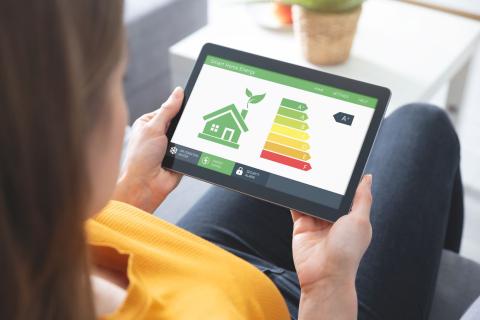‘Smart measures will make sustainability attainable and affordable for everyone’
High house prices, high energy bills, high investments in sustainability: the Dutch housing market is in turmoil, and many people are worried. Yet Professor of Real Estate Markets Dirk Brounen is hopeful for the future. ‘We are facing serious challenges, but I also see many positive developments, in which several parties play a role: homeowners, real estate agents, mortgage lenders, and the central government. A number of targeted measures will enable us to make a sustainable home attainable and affordable for all.’
Energy label
‘Achieving sustainability takes a long time. Take energy labels for houses. I’ve been researching them since 2011 and my findings show that A or B label houses sell for considerably higher prices than do F or G label houses. Over the years that gap has widened and that makes sense: for one thing, high-label houses have better insulation and their heating bills will consequently be lower. When making a bid, buyers factor that in.’

False incentive triggers short-term focus
‘Even so, real estate agents and appraisers weren’t exactly keen on energy labels in the early days. In fact, they initially started using release forms that allowed buyers and sellers to not have the energy label of the property determined. That seems to make little sense. Appraisers and real estate agents are best placed to share all information about houses and the energy label had been introduced to increase transparency. Yet in sidelining the energy label as much as possible, they achieved the exact opposite. But on reflection it does make sense: their commission is a percentage of the sales price. That makes an F or G label house decidedly unattractive, as it comes with a lower price and therefore a lower commission. Such a false incentive only encourages people to focus on the short term and to serve their own interests.’
We can no longer afford governments that neglect this topic.
Political reluctance
‘For years now, the government, too, does not appear overly convinced that sustainable homes should be prioritized. The Netherlands was one of the first EU countries to introduce the energy label, even if it did so lacking enthusiasm and intrinsic motivation. For example, it’s only in recent years that houses that are put up for sale must have an energy label. And even now there appears to be political reluctance to address this topic properly. It’s on table, but nothing much is happening. I believe it is a good thing that courts give the government a rap on the knuckles, reminding it to honor commitments it made in the past. We are no longer in a position to afford governments that neglect this topic and that do not do enough to achieve sustainability and the climate goals.’
Activating the right people
‘Because let’s face it: we must now act more decisively than ever before and it begins with understanding and with activating the right parties. I myself have been involved in the European CRREM project (Carbon Risk Real Estate Monitor) since 2019. This tool shows real estate investors how sustainable their portfolios are. We got the 34 largest investors on board right from the start. The CRREM is a free and open-source tool that clearly shows investors their current position and to what extent they are on schedule for achieving their 2030 and 2050 sustainability targets. By deliberately and immediately involving the largest parties, we have broken an impasse, and others are joining now in increasing numbers. The EU is even considering setting a compulsory minimum energy label for houses. Office buildings will already have to meet that requirement soon: as of 2023, every office building must meet at least energy labe. Office buildings that have a lower energy label can no longer be put on the rental market. This is an effective incentive for real estate owners to take action and do more to achieve sustainability.’
Investing
‘The general public, too, grasps the necessity of sustainability measures, especially now that energy costs have risen dramatically. Even so and even now, many are slow to act, preferring to pay a little too much for their energy each month rather than invest thousands of euros all at once on cavity wall insulation, even though economically that would be the far more sensible move. Eventually, such a lump sum investment will undoubtedly be recouped, especially given the current energy prices. Add to that the fact that some own hold houses and have low incomes, which means they simply cannot pay for these measures themselves. The government does offer subsidies, but so far these mostly go to people who have the means to fund sustainability measures themselves. And they are also often more adept at identifying subsidization opportunities.
Currently, subsidies go to people who have the means to fund sustainability measures themselves.
Taking a closer look at sustainability
‘Another measure that is economically unwise is the across-the-board energy bill reduction for all Dutch households. Part of that money now goes to people who have no trouble paying their energy bills. Besides, it would have been wiser to invest these millions in measures to make houses more energy efficient; future energy demand for heating them would be lower and people’s heating costs would be structurally lower. This would benefit us as a society more than endlessly fighting symptoms.’
Text continues below photo.

Subsidizing the right target demographics
‘One option to fund sustainability measures fairly is a CO2 tax: everyone in the Netherlands pays tax on the CO2 they emit, and the government earmarks the revenue to help people on low incomes to make their homes sustainable. An alternative approach could be to tax all above-average energy consumption more heavily. This will require political guts, because it’s a highly sensitive issue and a tall order in a country that rests on coalitions and consensus. But economically it would be the smart thing to do, and everything hangs on good communication. I’m confident wealthy people can be persuaded that subsidies should only be given to those that really need them.’
Showing interest and awareness of urgency
‘A more sustainable housing market requires everyone involved to show interest and to be aware of the urgency. My students frequently amaze me with their smart ideas. I’m sure civil servants have come up with many of these ideas themselves, but so far they have not yet filtered up to the top. Ministers must often compromise and because of that the outcome isn’t always the best solution. And there’s plenty other major players on the real estate market can do. Consider the NVM, the Dutch association of real estate agents. Until about three years ago they weren’t big fans of energy labels, and now they have set up their own Energy Desk as part of their ambition to become experts in this area. And slowly but surely, other parties are also starting to move. Together with the Ministry of Home Affairs I have conducted a number of exploratory surveys for each target demographic to review how, together with, for example, real estate agents, mortgage brokers, and banks, the sustainability drive of the housing market can be expedited. Those studies have yielded many useful and practicable ideas.’
Spotting and seizing opportunities
‘Let me give an example: banks. They now give a 0.2% discount on mortgage interests for A label houses. This encourages sustainable houses to be built and bought. A promising idea that came up in our exploratory studies concerns houses that are made energy efficient during the term of the owners’ mortgage loans and that are consequently awarded the A label later. These homeowners currently are not eligible for a mortgage interest discount, even though such a discount might be a strong financial incentive to improve the sustainability quotient of houses; given the money involved, even a reduction of just 0.2% can be appealing. It is important that we start spotting and seizing such opportunities together, all the while emphasizing the future benefits: lower energy consumption, lower energy costs, and a higher property value.’
A sustainable housing market needs a multidisciplinary approach
Attainable and affordable for everyone
‘There are many dimensions to making the housing market sustainable: economic, legal, psychological, and communicative. So what is needed is a multidisciplinary approach. If we put our backs into it together and draw on each other’s expertise, we can drive the message home. Even in our relatively conservative and aging real estate industry good things are happening. Every day in my work at the university I witness the optimism and creativity of the new generation to do things better and more sustainably. That’s why I have a positive outlook on the future; I am hopeful that we will be able to encourage each other to share good ideas and to monitor progress using basic tools. This will allow us to move closer, step by step, to a sustainable housing market in the Netherlands in a way that is attainable and affordable for all.’
About Dirk Brounen
Dr. Dirk Brounen is Professor of Real Estate Economics at the Tilburg School of Economics and Management of Tilburg University. His research interests include the international real estate sector and in particular the risks of and return on real estate investments, the added value of sustainable redevelopment of real estate, and the importance of financial literacy of decision makers. He also teaches various financial courses on real estate at TIAS and he is the author of the book Nooit Meer Slapend Arm.

Date of publication: 16 November 2022
